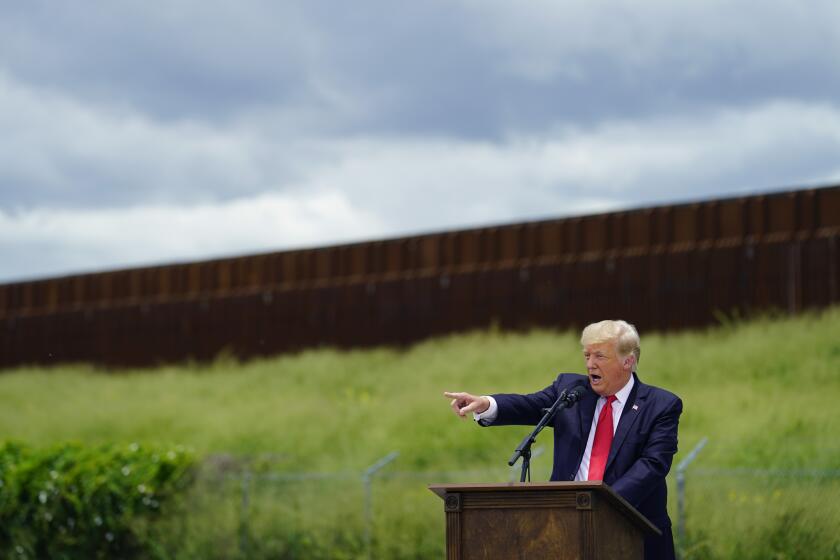Legislator Blames Infant Deaths, Disabilities on Medi-Cal Cuts
SACRAMENTO â The co-chairman of a legislative task force charged Wednesday that spending cuts in the stateâs Medi-Cal program have led to âtotally avoidable deaths and disabilitiesâ among the infants of poor women.
Assemblyman Bruce Bronzan, who has been conducting hearings on budget cuts in the stateâs $5-billion Medi-Cal program, made the charge during a joint hearing of the Senate and Assembly budget committees on Gov. George Deukmejianâs proposed $39-billion budget.
Complaining of further proposed budget cuts in the Medi-Cal program by the governor, Bronzan (D-Fresno) told state Finance Director Jesse R. Huff that because of the infant mortality deaths, âwe must do something about this.â
Medi-Cal Cuts Blamed
Bronzan said, âMorbidity and mortality statistics for obstetrical care and medically indigent adults have increased over the last few years because of the cuts in Medi-Cal.â
The Democratic lawmaker asserted that this led to âtotally avoidable deaths and disabilities.â
Bronzan supported his statements with an 18-month study released last month by the Southern California Child Health Network and the Childrenâs Research Institute of California.
Among other things, the report said this year an estimated 40,000 babies will die at birth or soon after or will begin their lives at risk to serious medical problems that are largely preventable.
The report also said California in recent years has dropped from having the seventh-best record in the nation in preventing infant deaths to 14th place, a decline largely attributed to the rising number of women for whom prenatal care is either late or nonexistent.
Responding for Deukmejian, William J. Ihle, spokesman for the Department of Health Services, which runs the Medi-Cal program, said statistics kept by the department tended not to support Bronzanâs argument.
Ihle said the infant mortality rate in California dropped between 1983 and 1984 and then rose somewhat during 1985, the last year for which statistics were available. Ihle said that in 1983, the state experienced 9.7 deaths per 1,000 live births, with the number dropping to 9.4 deaths per 1,000 in 1984, then rising to 9.5 in 1985.
Spontaneous Exchange
Bronzan made the charge about the impact of Medi-Cal cuts during a spontaneous exchange that developed during Huffâs testimony at the joint budget committee hearing.
Democrats are pressuring Deukmejian to restore $18.7 million in Medi-Cal cuts in the current yearâs budget and an additional $125 million in cuts proposed for the fiscal year that starts July 1. On top of that, the governor is expected to unveil proposals to revamp Medi-Cal, which could reduce spending by another $300 million.
Huff, during the exchange with Bronzan, said the Deukmejian Administration would be willing to listen to arguments in favor of increasing funding for Medi-Cal if lawmakers were willing to make cuts in other programs.
During the hearing, lawmakers also received briefings from Legislative Analyst Elizabeth G. Hill and Linda Proaps, executive secretary of the Commission on State Finance, an independent state agency that monitors revenues and expenditures.
The two officials differed sharply with Huff in assessing the stateâs fiscal situation.
The result of their conflicting views on such important issues as the level of next yearâs tax revenues or whether California government has already reached its constitutional spending limit further muddled an already chaotic budget picture.
Deukmejianâs proposed spending plan, prepared by Huff, anticipates that the state will end the current budget year $421 million below the spending limit and will finish the next fiscal year $80 million under the limit.
But Hill, the Legislatureâs nonpartisan budget analyst, repeated her position that the state will finish this year $221 million over the limit and will end the next year $587 million above the ceiling.
Jump in Receipts
The dispute over tax revenues centers on a major jump in receipts in December and January.
Huff so far has insisted that the increase of $559 million over his budget projections is in large part a âtemporaryâ phenomenon due to Californiansâ rushing to pay state tax bills in December to take advantages in changes in federal tax law. Since state taxes can be deducted when computing federal tax obligations, many wealthy Californians were in line for larger deductions if they paid their taxes in 1986. Huff has reported receiving âa bagful of checks dated Dec. 31,â and he said those checks were expected in April, anyway.
In her testimony, Proaps said the Commission on State Finance believes that while part of the increase may be due to federal tax law changes, Huffâs Department of Finance is underestimating tax revenues by $705 million over the next two years--$250 million during the current year and $455 million next year.
More to Read
Get the L.A. Times Politics newsletter
Deeply reported insights into legislation, politics and policy from Sacramento, Washington and beyond. In your inbox three times per week.
You may occasionally receive promotional content from the Los Angeles Times.



![[20060326 (LA/A20) -- STATING THE CASE: Marchers organized by unions, religious organizations and immigrants rights groups carry signs and chant in downtown L.A. "People are really upset that all the work they do, everything that they give to this nation, is ignored," said Angelica Salas of the Coalition of Humane Immigrant Rights. -- PHOTOGRAPHER: Photographs by Gina Ferazzi The Los Angeles Times] *** [Ferazzi, Gina -- - 109170.ME.0325.rights.12.GMF- Gina Ferazzi/Los Angeles Times - Thousands of protesters march to city hall in downtown Los Angeles Saturday, March 25, 2006. They are protesting against House-passed HR 4437, an anti-immigration bill that opponents say will criminalize millions of immigrant families and anyone who comes into contact with them.]](https://ca-times.brightspotcdn.com/dims4/default/34f403d/2147483647/strip/true/crop/1983x1322+109+0/resize/840x560!/quality/75/?url=https%3A%2F%2Fcalifornia-times-brightspot.s3.amazonaws.com%2Fzbk%2Fdamlat_images%2FLA%2FLA_PHOTO_ARCHIVE%2FSDOCS%2854%29%2Fkx3lslnc.JPG)






